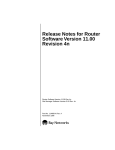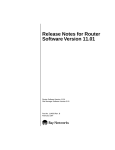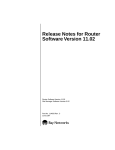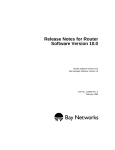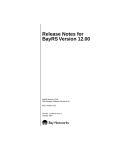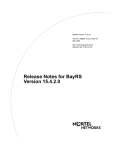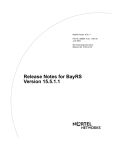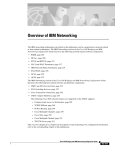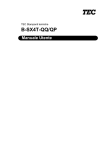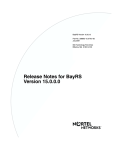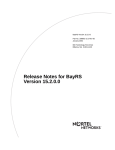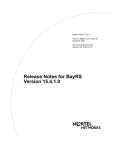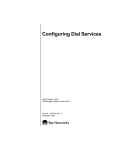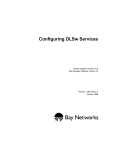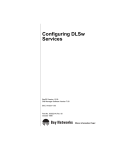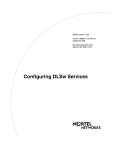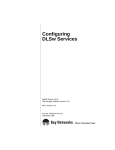Download Avaya Router Software 11.00 Release Notes
Transcript
Release Notes for Router Software Version 11.0 Router Software Version 11.0 Site Manager Software Version 5.0 Part No. 114093 Rev. A August 1996 4401 Great America Parkway Santa Clara, CA 95054 8 Federal Street Billerica, MA 01821 Copyright © 1988–1996 Bay Networks, Inc. All rights reserved. Printed in the USA. August 1996. The information in this document is subject to change without notice. The statements, configurations, technical data, and recommendations in this document are believed to be accurate and reliable, but are presented without express or implied warranty. Users must take full responsibility for their applications of any products specified in this document. The information in this document is proprietary to Bay Networks, Inc. The software described in this document is furnished under a license agreement and may only be used in accordance with the terms of that license. A summary of the Software License is included in this document. Restricted Rights Legend Use, duplication, or disclosure by the United States Government is subject to restrictions as set forth in subparagraph (c)(1)(ii) of the Rights in Technical Data and Computer Software clause at DFARS 252.227-7013. Notice for All Other Executive Agencies Notwithstanding any other license agreement that may pertain to, or accompany the delivery of, this computer software, the rights of the United States Government regarding its use, reproduction, and disclosure are as set forth in the Commercial Computer Software-Restricted Rights clause at FAR 52.227-19. Trademarks of Bay Networks, Inc. ACE, AFN, AN, BCN, BLN, BN, BNX, CN, FN, FRE, GAME, LN, Optivity, PPX, SynOptics, SynOptics Communications, Wellfleet and the Wellfleet logo are registered trademarks and ANH, ASN, Bay•SIS, BayStack, BCNX, BLNX, EZ Install, EZ Internetwork, EZ LAN, PathMan, PhonePlus, Quick2Config, RouterMan, SPEX, Bay Networks, Bay Networks Press, the Bay Networks logo and the SynOptics logo are trademarks of Bay Networks, Inc. Third-Party Trademarks All other trademarks and registered trademarks are the property of their respective owners. Statement of Conditions In the interest of improving internal design, operational function, and/or reliability, Bay Networks, Inc. reserves the right to make changes to the products described in this document without notice. Bay Networks, Inc. does not assume any liability that may occur due to the use or application of the product(s) or circuit layout(s) described herein. Portions of the code in this software product are Copyright © 1988, Regents of the University of California. All rights reserved. Redistribution and use in source and binary forms of such portions are permitted, provided that the above copyright notice and this paragraph are duplicated in all such forms and that any documentation, advertising materials, and other materials related to such distribution and use acknowledge that such portions of the software were developed by the University of California, Berkeley. The name of the University may not be used to endorse or promote products derived from such portions of the software without specific prior written permission. SUCH PORTIONS OF THE SOFTWARE ARE PROVIDED “AS IS” AND WITHOUT ANY EXPRESS OR IMPLIED WARRANTIES, INCLUDING, WITHOUT LIMITATION, THE IMPLIED WARRANTIES OF MERCHANTABILITY AND FITNESS FOR A PARTICULAR PURPOSE. In addition, the program and information contained herein are licensed only pursuant to a license agreement that contains restrictions on use and disclosure (that may incorporate by reference certain limitations and notices imposed by third parties). ii 114093 Rev. A Bay Networks Software License Note: This is Bay Networks basic license document. In the absence of a software license agreement specifying varying terms, this license -- or the license included with the particular product -- shall govern licensee’s use of Bay Networks software. This Software License shall govern the licensing of all software provided to licensee by Bay Networks (“Software”). Bay Networks will provide licensee with Software in machine-readable form and related documentation (“Documentation”). The Software provided under this license is proprietary to Bay Networks and to third parties from whom Bay Networks has acquired license rights. Bay Networks will not grant any Software license whatsoever, either explicitly or implicitly, except by acceptance of an order for either Software or for a Bay Networks product (“Equipment”) that is packaged with Software. Each such license is subject to the following restrictions: 1. Upon delivery of the Software, Bay Networks grants to licensee a personal, nontransferable, nonexclusive license to use the Software with the Equipment with which or for which it was originally acquired, including use at any of licensee’s facilities to which the Equipment may be transferred, for the useful life of the Equipment unless earlier terminated by default or cancellation. Use of the Software shall be limited to such Equipment and to such facility. Software which is licensed for use on hardware not offered by Bay Networks is not subject to restricted use on any Equipment, however, unless otherwise specified on the Documentation, each licensed copy of such Software may only be installed on one hardware item at any time. 2. Licensee may use the Software with backup Equipment only if the Equipment with which or for which it was acquired is inoperative. 3. Licensee may make a single copy of the Software (but not firmware) for safekeeping (archives) or backup purposes. 4. Licensee may modify Software (but not firmware), or combine it with other software, subject to the provision that those portions of the resulting software which incorporate Software are subject to the restrictions of this license. Licensee shall not make the resulting software available for use by any third party. 5. Neither title nor ownership to Software passes to licensee. 6. Licensee shall not provide, or otherwise make available, any Software, in whole or in part, in any form, to any third party. Third parties do not include consultants, subcontractors, or agents of licensee who have licensee’s permission to use the Software at licensee’s facility, and who have agreed in writing to use the Software only in accordance with the restrictions of this license. 7. Third-party owners from whom Bay Networks has acquired license rights to software that is incorporated into Bay Networks products shall have the right to enforce the provisions of this license against licensee. 8. Licensee shall not remove or obscure any copyright, patent, trademark, trade secret, or similar intellectual property or restricted rights notice within or affixed to any Software and shall reproduce and affix such notice on any backup copy of Software or copies of software resulting from modification or combination performed by licensee as permitted by this license. 114093 Rev. A iii Bay Networks Software License (continued) 9. Licensee shall not reverse assemble, reverse compile, or in any way reverse engineer the Software. [Note: For licensees in the European Community, the Software Directive dated 14 May 1991 (as may be amended from time to time) shall apply for interoperability purposes. Licensee must notify Bay Networks in writing of any such intended examination of the Software and Bay Networks may provide review and assistance.] 10. Notwithstanding any foregoing terms to the contrary, if licensee licenses the Bay Networks product “Site Manager,” licensee may duplicate and install the Site Manager product as specified in the Documentation. This right is granted solely as necessary for use of Site Manager on hardware installed with licensee’s network. 11. This license will automatically terminate upon improper handling of Software, such as by disclosure, or Bay Networks may terminate this license by written notice to licensee if licensee fails to comply with any of the material provisions of this license and fails to cure such failure within thirty (30) days after the receipt of written notice from Bay Networks. Upon termination of this license, licensee shall discontinue all use of the Software and return the Software and Documentation, including all copies, to Bay Networks. 12. Licensee’s obligations under this license shall survive expiration or termination of this license. iv 114093 Rev. A Contents Release Notes for Router Software Version 11.0 i Technical Support and Online Services Bay Networks Customer Service ......................................................................................xii Bay Networks Information Services .................................................................................xiii World Wide Web ........................................................................................................xiii Customer Service FTP ..............................................................................................xiii Support Source CD ...................................................................................................xiv CompuServe .............................................................................................................xiv InfoFACTS ................................................................................................................. xv How to Get Help ........................................................................................................ xv Release Notes for Router Software Version 11.0 Protocols Supported .......................................................................................................... 2 Upgrading to Version 11.0/5.0 ........................................................................................... 3 New Features in Version 11.0 ............................................................................................ 4 MCE1 Net Module ....................................................................................................... 4 Data Link Switching (DLSw) Services ......................................................................... 4 Dial Services ............................................................................................................... 5 Dial Backup of Multilink Leased Lines .................................................................. 5 Dial Backup over Frame Relay ............................................................................. 5 Dial Optimized Routing ......................................................................................... 5 Inactivity Mode ...................................................................................................... 6 Traffic Filters ......................................................................................................... 6 PRI Multirate ......................................................................................................... 6 PRI Support for the ASN ...................................................................................... 6 BRI Leased Line Operation for Japan .................................................................. 6 Point-to-Point Protocol (PPP) Services ....................................................................... 7 Asynchronous PPP ............................................................................................... 7 Additional Lines in a Multilink Bundle ................................................................... 7 114093 Rev. A v Multilink Fragmentation ......................................................................................... 7 One-Way Authentication ....................................................................................... 7 Disabling Loopback Detection .............................................................................. 8 Frame Relay Service Records .................................................................................... 8 Hardware Compression for Frame Relay and PPP on the ASN ................................. 8 Interface Redundancy ................................................................................................. 8 X.25 Services .............................................................................................................. 9 IPEX ..................................................................................................................... 9 X.25 Support for RFC 1356 .................................................................................. 9 IP Services .................................................................................................................. 9 RIP Support for Dial-Optimized Routing ............................................................... 9 IP Accounting Support for Frame Relay Interfaces ............................................. 10 ISP Mode ............................................................................................................ 10 Dynamic BGP Policy Configuration .................................................................... 10 BGP Communities .............................................................................................. 11 Simplified Regular Expressions for BGP AS Pattern Matching .......................... 11 Static Host Entry Support for IGMP .................................................................... 11 NTP Support ............................................................................................................. 11 Line Resource Reservation for 100-Mb/s Ethernet Circuits ...................................... 12 New and Enhanced Technician Interface Scripts ...................................................... 12 Guidelines for Using Version 11.0 .................................................................................... 13 IP Equal-Cost Multipath Routing ............................................................................... 13 DCM Software Image and Router Software Compatibility ........................................ 13 Configuring an AN Router that Supports the RMON DCM (Board) .......................... 13 Joining an Incompatible Emulated LAN .................................................................... 13 Quad Multichannel T1 Link Module ........................................................................... 14 Netboot on a System 5780 ATM Router .................................................................... 14 Support for Banyan 80C4 ISAP ................................................................................ 14 Increasing AN and ANH Memory Partitions .............................................................. 14 Using IPX Dial Optimized Routing (DOR) ................................................................. 15 Inactivity Mode .................................................................................................... 15 RIP/SAP Pace and Packet Size Parameters ...................................................... 15 Diagnostic Packets and Time Synchronization ................................................... 15 Using Frame Relay Service Records ........................................................................ 16 Using Demand Circuits for Backup ........................................................................... 18 vi 114093 Rev. A Making the Configuration Work by Configuring an Unused Port ........................ 18 Supported Flash Memory Cards ..................................................................................... 20 Standards Supported ...................................................................................................... 21 Supported AFN, BayStack AN/ANH, and ASN Models, and Link Modules ..................... 25 114093 Rev. A vii viii 114093 Rev. A Tables Table 1. Table 2. 114093 Rev. A Approved Flash Memory Cards ................................................................ 20 Standards Supported by Version 11.0 ...................................................... 21 ix Technical Support and Online Services To ensure comprehensive network support to our customers and partners worldwide, Bay Networks Customer Service has Technical Response Centers in key locations around the globe: • • • • • Billerica, Massachusetts Santa Clara, California Sydney, Australia Tokyo, Japan Valbonne, France The Technical Response Centers are connected via a redundant Frame Relay Network to a Common Problem Resolution system, enabling them to transmit and share information, and to provide live, around-the-clock support 365 days a year. Bay Networks Information Services complement the Bay Networks Service program portfolio by giving customers and partners access to the most current technical and support information through a choice of access/retrieval means. These include the World Wide Web, CompuServe, Support Source CD, Customer Support FTP, and InfoFACTS document fax service. 114093 Rev. A xi Release Notes for Router Software 11.0 Bay Networks Customer Service If you purchased your Bay Networks product from a distributor or authorized reseller, contact that distributor’s or reseller’s technical support staff for assistance with installation, configuration, troubleshooting, or integration issues. Customers can also purchase direct support from Bay Networks through a variety of service programs. As part of our PhonePlus™ program, Bay Networks Service sets the industry standard, with 24-hour, 7-days-a-week telephone support available worldwide at no extra cost. Our complete range of contract and noncontract services also includes equipment staging and integration, installation support, on-site services, and replacement parts delivery -- within approximately 4 hours. To purchase any of the Bay Networks support programs, or if you have questions on program features, use the following numbers: Region Telephone Number Fax Number United States and Canada 1-800-2LANWAN; enter Express Routing Code (ERC) 290 when prompted (508) 670-8766 (508) 436-8880 (direct) Europe (33) 92-968-300 (33) 92-968-301 Asia/Pacific Region (612) 9927-8800 (612) 9927-8811 Latin America (407) 997-1713 (407) 997-1714 In addition, you can receive information on support programs from your local Bay Networks field sales office, or purchase Bay Networks support directly from your authorized partner. xii 114093 Rev. A Technical Support and Online Services Bay Networks Information Services Bay Networks Information Services provide up-to-date support information as a first-line resource for network administration, expansion, and maintenance. This information is available from a variety of sources. World Wide Web The Bay Networks Customer Support Web Server offers a diverse library of technical documents, software agents, and other important technical information to Bay Networks customers and partners. A special benefit for contracted customers and resellers is the ability to access the Web Server to perform Case Management. This feature enables your support staff to interact directly with the network experts in our worldwide Technical Response Centers. A registered contact with a valid Site ID can • View a listing of support cases and determine the current status of any open case. Case history data includes severity designation, and telephone, e-mail, or other logs associated with the case. • Customize the listing of cases according to a variety of criteria, including date, severity, status, and case ID. • Log notes to existing open cases. • Create new cases for rapid, efficient handling of noncritical network situations. • Communicate directly via e-mail with the specific technical resources assigned to your case. The Bay Networks URL is http://www.baynetworks.com. Customer Service is a menu item on that home page. Customer Service FTP Accessible via URL ftp://support.baynetworks.com (134.177.3.26), this site combines and organizes support files and documentation from across the Bay Networks product suite, including switching products from our Centillion™ and Xylogics® business units. Central management and sponsorship of this FTP site lets you quickly locate information on any of your Bay Networks products. 114093 Rev. A xiii Release Notes for Router Software 11.0 Support Source CD This CD-ROM -- sent quarterly to all contracted customers -- is a complete Bay Networks Service troubleshooting knowledge database with an intelligent text search engine. The Support Source CD contains extracts from our problem-tracking database; information from the Bay Networks Forum on CompuServe; comprehensive technical documentation, such as Customer Support Bulletins, Release Notes, software patches and fixes; and complete information on all Bay Networks Service programs. You can run a single version on Macintosh Windows 3.1, Windows 95, Windows NT, DOS, or UNIX computing platforms. A Web links feature enables you to go directly from the CD to various Bay Networks Web pages. CompuServe For assistance with noncritical network support issues, Bay Networks Information Services maintain an active forum on CompuServe, a global bulletin-board system. This forum provides file services, technology conferences, and a message section to get assistance from other users. The message section is monitored by Bay Networks engineers, who provide assistance wherever possible. Customers and resellers holding Bay Networks service contracts also have access to special libraries for advanced levels of support documentation and software. To take advantage of CompuServe’s recently enhanced menu options, the Bay Networks Forum has been re-engineered to allow links to our Web sites and FTP sites. We recommend the use of CompuServe Information Manager software to access these Bay Networks Information Services resources. To open an account and receive a local dial-up number in the United States, call CompuServe at 1-800-524-3388. Outside the United States, call 1-614-529-1349, or your nearest CompuServe office. Ask for Representative No. 591. When you are on line with your CompuServe account, you can reach us with the command GO BAYNET. xiv 114093 Rev. A Technical Support and Online Services InfoFACTS InfoFACTS is the Bay Networks free 24-hour fax-on-demand service. This automated system has libraries of technical and product documents designed to help you manage and troubleshoot your Bay Networks products. The system responds to a fax from the caller or to a third party within minutes of being accessed. To use InfoFACTS in the United States or Canada, call toll-free 1-800-786-3228. Outside North America, toll calls can be made to 1-408-764-1002. In Europe, toll-free numbers are also available for contacting both InfoFACTS and CompuServe. Please check our Web page for the listing in your country. How to Get Help Use the following numbers to reach your Bay Networks Technical Response Center: 114093 Rev. A Technical Response Center Telephone Number Fax Number Billerica, MA 1-800-2LANWAN (508) 670-8765 Santa Clara, CA 1-800-2LANWAN (408) 764-1188 Valbonne, France (33) 92-968-968 (33) 92-966-998 Sydney, Australia (612) 9927-8800 (612) 9927-8811 Tokyo, Japan (81) 3-5402-0180 (81) 3-5402-0173 xv Release Notes for Router Software Version 11.0 This document contains the latest information about Bay Networks™ Router Software Version 11.0: 114093 Rev. A • Supported bridging/routing protocols • Upgrading information • New features • Guidelines for using Version 11.0 • Supported router modules • Tested configurations • Supported Flash memory cards • Supported standards 1 Release Notes for Router Software Version 11.0 Protocols Supported Version 11.0 of Bay Networks Router Software supports the following bridging/routing protocols and router configuration features: 2 • AppleTalk and AppleTalk Update-based Routing Protocol (AURP) • Advanced Peer-to-Peer Networking (APPN) • Asynchronous Transfer Mode (ATM) • ATM Data Exchange Interface (ATMDXI) • ATM LAN Emulation • Binary Synchronous Communication Type 3 (BSC3) • Bootstrap Protocol (BOOTP) • Border Gateway Protocol (BGP-3 and BGP-4) • Classless Inter-Domain Routing (CIDR) • Data Compression • Data Link Switching (DLSw) • DECnet Phase IV Routing Protocol • Dial Backup, Dial-on-Demand, and Bandwidth-on-Demand • Distance Vector Multicast Routing Protocol (DVMRP) • Dynamic Host Configuration Protocol (DHCP) • Exterior Gateway Protocol-2 (EGP-2) • Frame Relay • File Transfer Protocol (FTP) • HP Probe Protocol • Inbound and Outbound Traffic Filter Features • Integrated Services Digital Network (ISDN) • Interface Redundancy • Internet Gateway Management Protocol (IGMP) • Internet Protocol (IP) • Internet Packet Exchange (IPX) Protocol 114093 Rev. A Release Notes for Router Software Version 11.0 • Internet Service Provider Mode • Internet Stream Protocol (ST2) • Learning Bridge and Spanning Tree Protocols • Logical Link Control 2 (LLC2) Protocol • Native Mode LAN (NML) Protocol • Network Time Protocol (NTP) • Open Shortest Path First (OSPF) Protocol • Open Systems Interconnection (OSI) Routing Protocol • Point-to-Point Protocol (PPP) • Protocol Prioritization • Router Discovery • Router Redundancy • Synchronous Data Link Control (SDLC) • Simple Network Management Protocol (SNMP) • Source Routing Bridge Protocol • Switched Multi-Megabit Data Service (SMDS) • Telnet Protocol (Inbound and Outbound) • Transmission Control Protocol (TCP) • Transparent-to-Source Routing Translation Bridge • Virtual Networking System (VINES) • X.25 Protocol • XMODEM and YMODEM Protocols • Xerox Network Systems (XNS) Protocol Upgrading to Version 11.0/5.0 To upgrade your router software to Version 11.0, or to upgrade your Site Manager software to Version 5.0, refer to Upgrading Routers from Version 7-9.xx to Version 11.0 for instructions. This document is included in your upgrade package. These Release Notes also contain information relevant to upgrading routers. 114093 Rev. A 3 Release Notes for Router Software Version 11.0 New Features in Version 11.0 Bay Networks has implemented many changes to the router software for Version 11.0. This section describes the major new features in this release. MCE1 Net Module With Release 11.0, the MCE1 net module is now supported on 5380 and 5580 routers. Data Link Switching (DLSw) Services Version 11.0 includes support for RFC 1795. For complete information, refer to Configuring DLSw Services. RFC 1795, called DLSw Version 1, is an implementation of DLSw developed by a consortium of vendors. RFC 1795 supersedes the original DLSw specification, RFC 1434. Starting with Version 11.0, Bay Networks DLSw routers support RFC 1795. These routers are fully compatible with Bay Networks routers that support the original RFC 1434 specification with Version 10.0 or earlier software. Based on RFC 1434, RFC 1795 includes features that were not originally published, as well as modifications to the standard. RFC 1795 includes • Modified frame format for session setup, including a field for the largest frame size. • Directed broadcast CANUREACH and ICANREACH control frames. This feature reduces broadcasting over the network. • Capabilities exchange, allowing routers to exchange resource information about each other. Capabilities exchange flows operate in three categories: -- Fixed information, such as an organization’s router software version -- Customized information, where one router transfers the information to another router -- Negotiation, where routers negotiate the use of proprietary functions (and only if both routers support the functions under negotiation) • 4 Rate-based pacing, a new standard for flow control between routers. 114093 Rev. A Release Notes for Router Software Version 11.0 Flow control allows a DLSw router to inform another router to slow down or stop sending data when the receiving buffer(s) fill up. Rate-based flow control uses a windowing mechanism that allows the routers to send more or fewer packets, based on the state of the last receive window. If the router successfully receives the last transmission, it informs the sending router to continue to send more packets. Flow control is essential for successful delivery of SNA and NetBIOS data. Dial Services The following features are new in Version 11.0 for Dial services. For important information about using demand circuits for backup, see “Guidelines for Using Version 11.0,” later in these release notes. Dial Backup of Multilink Leased Lines Dial backup service is now available for leased multilink connections. In previous releases, it was available for only a single leased line or a leased multiline (Standard and PPP only). For more information, refer to Configuring Dial Services, Chapter 1. Dial Backup over Frame Relay Dial backup service is now available for an entire Frame Relay interface using Frame Relay across the backup circuit. You can now back up the entire Frame Relay interface, which means you can back up multiple PVCs instead of just one PVC. In previous releases, you could only back up a single Frame Relay PVC using PPP across the backup circuit. For more information, refer to Configuring Dial Services, Chapter 1. Dial Optimized Routing Dial optimized routing lets you exchange IP RIP and IPX RIP/SAP routing updates when a connection is active for data transmission. By limiting when the router can send updates, dial optimized routing reduces unnecessary connections and line costs. For more information, see Configuring Dial Services, Chapter 4. 114093 Rev. A 5 Release Notes for Router Software Version 11.0 Inactivity Mode We have added inactivity mode and inactivity timer parameters to monitor inactivity based on the direction of traffic (transmit, receive, both, or either). You can configure inactivity mode for both inbound and outbound traffic. PPP’s LQR, LCP, and periodic CHAP messages will not reset inactivity. For more information, refer to Configuring Dial Services, Chapter 8. Traffic Filters We have added new rules for traffic filters. To prevent routing updates and protocol-specific messages from keeping the circuit up, you can configure traffic filters that specify which packets are permitted across an established dial-up line and which packets are prevented from bringing up a dial-up line. You can also filter outbound packets to prevent the inactivity timer from resetting. For more information, refer to Configuring Dial Services, Chapter 4. PRI Multirate PRI multirate enables you to specify how many B channels will be allocated on a call-by-call basis. Depending on how many B channels you combine, the bandwidth can range from 128 Kb/s to 1472 Kb/s. This allows you to choose the most suitable bandwidth for an application. Applications such as dial backup and video conferences benefit from the flexibility of multirate service. Also, service providers offer multirate service at low tariffs relative to other ISDN services, which makes it a good option for many applications. For more information, refer to Configuring Dial Services, Chapter 3. PRI Support for the ASN The ASN™ now offers ISDN PRI service. For more information, refer to Configuring Dial Services, Chapter 3. BRI Leased Line Operation for Japan For BRI service in Japan, the router allows you to support a permanent point-to-point ISDN connection over a B channel without having to use the D channel to dial the call. This connection operates like a leased line. This option is useful when ISDN service providers do not use the D channel. For more information, refer to Configuring Dial Services, Chapter 3. 6 114093 Rev. A Release Notes for Router Software Version 11.0 Point-to-Point Protocol (PPP) Services The following features are new in Version 11.0 for PPP. Asynchronous PPP With Version 11.0, PPP supports the use of asynchronous modems connected to QUICC-based COM ports (that is, BayStack™ AN®, ASN, and BN® router octal sync modules support async ports). Asynchronous PPP support lets you use less expensive asynchronous modems to dial in to a Bay Networks router or terminal server. Asynchronous PPP is implemented as described in RFC 1662. Additional Lines in a Multilink Bundle The maximum number of lines allowed in a multilink bundle is now 30. The actual practical maximum depends on the nature of the network traffic and the network configuration. Multilink Fragmentation Enabling fragmentation means that PPP can split packets when necessary for better performance. With fragmentation enabled, PPP can split packets into fragments, then send the fragments over the lines in the multilink bundle, reassembling them on the receiving peer into the proper sequence. You can specify the minimum packet size to be considered for fragmentation. Multilink fragmentation is implemented as described in RFC 1717. One-Way Authentication One-way authentication uses an authentication protocol on only one side of a dial-up connection. The router placing the call disables the authentication protocol for a circuit, while the router on the receiving side enables authentication. Disabling the outbound authentication lets the router interoperate with other devices that may not allow two-way authentication or support CHAP. To use one-way authentication, you must also configure certain options for the switched circuit itself. See Configuring Dial Services for a description of how you must set up dial services to enable one-way authentication. 114093 Rev. A 7 Release Notes for Router Software Version 11.0 Disabling Loopback Detection As part of its network integrity checking, PPP tests for a loopback condition in which, effectively, the router is talking with itself and not communicating with the network. In Version 11.0, for test purposes, you can disable this loopback detection feature. For more information on these features, refer to Configuring PPP Services and Configuring Dial Services. Frame Relay Service Records Bay Networks now uses service records to define Frame Relay circuits. A service record is a data structure that allows flexible grouping and characterization of PVCs. A service record can contain a single PVC or multiple PVCs. For further information about Bay Networks implementation of service records, refer to Configuring Frame Relay Services. For information about how service records differ from access modes, see “Guidelines for Using Version 11.0,” later in these release notes. Hardware Compression for Frame Relay and PPP on the ASN Our compression services now include hardware-based compression for Frame Relay and PPP networks for the ASN. A compression net module compresses data transmitted over a WAN network by dual synchronous, MCE1/ISDN PRI, dual sync with ISDN BRI, and Quad BRI net modules. For further information about Bay Networks data compression services, refer to Configuring Data Compression Services. Interface Redundancy Interface redundancy now works with AppleTalk and VINES. For further information about interface redundancy, refer to Configuring Interface and Router Redundancy. 8 114093 Rev. A Release Notes for Router Software Version 11.0 X.25 Services We have added the following new features to the X.25 services IPEX Bay Networks X.25 services now include tunneling over TCP/IP Internet (IPEX). IPEX lets you send and receive messages between two X.25 systems via a TCP/IP network. The tunneling maps TCP sockets to X.25 virtual circuits. IPEX works with X.25 switched virtual circuits (SVCs) as well as with TCP/IP protocols over all interface types that Bay Networks routers support. For further information about IPEX, refer to Configuring X.25 Services. X.25 Support for RFC 1356 RFC 1356 defines a standard for multiprotocol encapsulation over X.25 networks. Bay Networks implements RFC 1356 for IP, OSI, IPX, DECnet, and XNS. This means you can use Bay Networks routers at one end of a connection, and equipment from another vendor (that also supports RFC 1356 for these protocols) at the other end of the connection. For further information about RFC 1356, refer to Configuring X.25 Services. IP Services The following features are new in 11.0 for IP services. RIP Support for Dial-Optimized Routing Dial-optimized routing (DOR) reduces costs on dialed lines. Under DOR, RIP exchanges routing information on the interface only when the router or a peer has activated the connection for a data transmission. RIP does not initiate a connection on a dialed line just to issue a routing update, unless it is the first time the dial line is initialized. For information on configuring a RIP interface for DOR, see Configuring IP Services, Chapter 4. 114093 Rev. A 9 Release Notes for Router Software Version 11.0 IP Accounting Support for Frame Relay Interfaces IP Accounting counts transit data packets -- that is, packets that IP receives on one interface and forwards to another interface. This mechanism allows a network service provider to bill a network user according to the amount of data routed between two locations. Bay Networks currently provides IP accounting support for Frame Relay networks. For information on configuring a Frame Relay interface for IP accounting, see Configuring IP Services, Chapter 3. IP accounting keeps track of transit data packets by making an entry for each packet in an IP accounting table. Each entry includes the source and destination addresses of the packet, the number of packets forwarded, and the number of bytes forwarded. ISP Mode ISP mode provides the following features for internet service providers (ISPs). • Suppression of IP forwarding tables. By default, IP maintains a forwarding table on each IP interface. IP uses this table as a cache for routes that are frequently used to forward data packets that arrive on the interface. In ISP mode, IP does not use forwarding tables. • BGP soloist By default, BGP runs on all slots configured with IP interfaces. In ISP mode, BGP runs as a soloist. By default, ISP mode features are disabled on the router. For information, see Configuring IP Services, Chapter 3. Dynamic BGP Policy Configuration By default, BGP configures IP policies dynamically. This means that if you modify a policy, BGP dynamically re-evaluates all affected routes as a result. For complete information on BGP dynamic policy configuration, see Configuring IP Services, Chapter 6. 10 114093 Rev. A Release Notes for Router Software Version 11.0 BGP Communities The BGP communities attribute identifies the communities to which the route belongs. (A community is a group of destinations that share some common property.) You can configure a BGP accept or announce policy to match a BGP community. For complete information, see Appendix B of Configuring IP Services. Simplified Regular Expressions for BGP AS Pattern Matching In the Bay Networks implementation of AS path pattern matching for Version 10.0, the user must know regular expression syntax. For Version 11.0, we have provided a simpler syntax. For complete information, see Configuring IP Services, Chapter 6. You can also use the ip bgp_routes command in the Technician Interface in AS pattern matching. For complete information, see Using Technician Interface Software, Chapter 8. Static Host Entry Support for IGMP A network may include a member of a multicast group that is unable to register its network with the local IGMP router; for example, a host that is a member of a multicast group but that is not running IGMP. In such a situation, you can register the group member’s network statically on the router. For complete information, refer to Configuring IP Multicast Services, Chapter 3. NTP Support The Network Time Protocol (NTP) synchronizes the timing of internal clocks of various internet devices across large, diverse networks to universal standard time. NTP runs over UDP, which in turn runs over IP. The NTP protocol specification is documented in RFC 1305. The current implementation of NTP supports only NTP Client mode. In this mode, the local NTP client, which runs on a router, accepts time information from other remote time servers and adjusts its clock accordingly. However, the NTP local client will not attempt to synchronize another device’s clock. 114093 Rev. A 11 Release Notes for Router Software Version 11.0 Line Resource Reservation for 100-Mb/s Ethernet Circuits You can now enable the Line Resource Manager (LRM) on 100-Mb/s Ethernet interfaces. The LRM allows you to configure quality of service (QoS) support for realtime applications, and simultaneously maintain bandwidth for other traffic. Using LRM, you define a percentage of a line’s bandwidth as reservable. Applications that require QoS support negotiate for the reservable bandwidth. See Configuring Line Services for more information. New and Enhanced Technician Interface Scripts This section describes new and enhanced Technician Interface scripts. For complete information, see Using Technician Interface Scripts. • show appn switch <RTP_conn_name> -- Adds a new option that requests the APPN node to perform a path switch with a currently active RTP connection, then displays the results. • show lane data_vcs -- Adds a new option that shows ATM control VCs and data VCs. • show ntp -- Adds a new command group that shows statistics for the Network Time Protocol. • show sws -- Adds options for on-demand dialing_groups, optimized_routing, and pap_chap_ information. • show x25 -- Adds options for IP over X.25 (ipex maps and ipex session). • show atmarp table -- Includes improved information on the contents of the VPI/VCI resolution table. • show atm interface -- Adds signaling version information to the display. • show isdn calls time -- Adds a circuit number column to the display. • show ds1e1 timeslot -- Improves the display with current, rather than originally configured DS1E1 timeslot assignments. • show csmacd, show ftp, show fr, show ip, show snmp, show sync, show tcp, show telnet, show tftp -- Updates displays for these embedded scripts. 12 • show process -- Updates sampling interval from 5 to 30 seconds for the buffers, cpu, and memory options. • show smds -- Adds some address verification information to the stats and circuit options. 114093 Rev. A Release Notes for Router Software Version 11.0 • show state all and show circuits -- Adds IPX SAP (IPX Service Advertising Protocol) information to displays. Guidelines for Using Version 11.0 The following guidelines are new in Version 11.0. IP Equal-Cost Multipath Routing Version 11.0 does not support IP equal-cost multipath routing for RIP and OSPF. DCM Software Image and Router Software Compatibility The Version 1.4 DCM software image is backward-compatible with Router Software Versions 9.0x and 10.0x. However, if you plan to run RMON on a Version 11.0 AN or ANH™ router, you must upgrade the DCM software image to Version 1.4 first. If you attempt to run RMON on an 11.0 router that has a DCM software image version earlier than Version 1.4 (for example, Version 1.3.0 or 1.3.1), you will get an error message from the RMON Summary application telling you that the router does not support RMON. Configuring an AN Router that Supports the RMON DCM (Board) To monitor an AN router containing an RMON DCM board with a tool such as Optivity® Analysis, you must first configure the Ethernet interface, using Site Manager. Joining an Incompatible Emulated LAN Bay Networks routers currently support only Ethernet IEEE 802.3 emulated LAN connectivity. When accepting the default, Unspecified, for the LEC LAN Type parameter, ensure that the LAN Emulation Configuration Server (LECS) supplies a configuration for an IEEE 802.3 emulated LAN. (Refer to Configuring ATM Services for more information about the LEC LAN Type parameter.) If the LECS tries to assign a client to a Token Ring 802.5 emulated LAN, the attempt fails and the router software generates the following log message: # 58: 01/11/96 17:05:59.714 WARNING SLOT 5 ATM_LE Code: 34 LEC: Config Resp incompatible LAN type (802.5) returned - FAILED 114093 Rev. A 13 Release Notes for Router Software Version 11.0 Quad Multichannel T1 Link Module The Quad Multichannel T1 (QMCT1) Link Module operates only in routers with a FRE®-2 series Fast Routing Engine processor. Netboot on a System 5780 ATM Router Netboot is not supported on a System 5780 ATM Router. Support for Banyan 80C4 ISAP Bay Networks routers now support the Banyan 80C4 ISAP on Ethernet. Increasing AN and ANH Memory Partitions AN and ANH memory partitions can be 1824 or 4800 bytes. By default, Token Ring AN routers initialize with a memory partition (buffer size) of 4800 bytes; Ethernet AN and ANH systems initialize with a buffer size of 1824 bytes. The Technician Interface stores the buffer size in nonvolatile read-access memory (NVRAM) and reads it at boot time. You can change the default buffer size for an AN or ANH. For example, if an Ethernet AN or ANH running OSPF/IP experiences problems resulting from small buffer sizes, you can increase the buffer size. This process is similar to carving local and global memory partitions; however, you cannot use Site Manager to perform buffer carving. • Set the buffer size on an AN or ANH system by entering the following commands at the Technician Interface prompt: Note: Be sure to enter the commands in the following order. set wfKernCfgParamEntry.wfKernCfgParamDelete.1 1 set wfKernCfgParamEntry.wfKernCfgParamBufSize.1 4800 (or 1824) The Technician Interface saves the new buffer size in NOVRAM, and uses this setting at subsequent boots to determine the buffer size. set wfKernCfgParamEntry.wfKernCfgParamDelete.1 2 14 114093 Rev. A Release Notes for Router Software Version 11.0 You must delete all instances of wfKernCfgParamEntry before saving the configuration file. commit reset 1 • Reset the buffer size back to the default value with these Technician Interface commands: set wfKernCfgParamEntry.wfKernCfgParamBufSizeReset.1 1 commit Using IPX Dial Optimized Routing (DOR) The following information will help you use DOR optimally. Inactivity Mode We recommend that you set the Inactivity Mode parameter to Transmit Only. Any other setting causes the inactivity mode to reset when the receive end can’t filter Serialization, Watchdog, and Keep Alive packets for NORESET. These packets could keep the demand line active for long periods of time. RIP/SAP Pace and Packet Size Parameters As IPX routes and services grow in number, IPX RIP and SAP packets may be clipped when an IPX DOR circuit comes up or changes state. To stop the clipping, reduce the value of the Pace parameter for RIP and SAP packets or change the RIP/SAP packet size for the IPX DOR circuit. You should reduce the RIP/SAP Pace parameter for IPX DOR circuits to accommodate the number of IPX routes and services in the network. Diagnostic Packets and Time Synchronization No default priority queuing filters exist for IPX diagnostics packets or packets used in NDS time synchronization. You can configure a priority queueing filter to keep IPX diagnostic packets from bringing up a demand line. However, since the Bay Networks IPX ping packet is a diagnostic packet, the filter will affect it as well. NDS time synchronization packets are treated as data packets. You can configure NetWare servers for larger polling intervals to reduce the frequency of bringing up the line for time synchronization packets. 114093 Rev. A 15 Release Notes for Router Software Version 11.0 Using Frame Relay Service Records The following sections compare service records to the access modes that formerly defined Bay Networks Frame Relay services. Group Access Mode In group access mode, upper-layer protocols treat each Frame Relay network interface as a single access point to the switched network. The upper-layer protocols use a single network address to send all traffic destined for the switched network to the Frame Relay network interface. When you configure each router, you assign only one network address, for example an IP or IPX address, to the Frame Relay interface, not to each PVC. The DLCMI dynamically configures PVCs; you do not need to explicitly configure them. Group access mode advantages are that it • Supports all protocols. • Simplifies network addressing because you define and associate only one protocol address with the Frame Relay interface. • Is easy to configure. • Conserves resources because it requires a small number of circuits. Its disadvantages are that it • Allows only one group of PVCs per Frame Relay connection. • Uses large amount of buffer space during broadcasts. • Increases customer costs because it has only a single broadcast domain. Service Records and Group Mode Service records retain all of the advantages of group mode. Service records also 16 • Allow multiple groups of PVCs per Frame Relay connection. • Enable you to gather multiple PVCs for each network protocol into a separate group or service record, thereby reducing the number of buffers needed per circuit during broadcasts. • Lower customer costs by creating multiple broadcast domains. 114093 Rev. A Release Notes for Router Software Version 11.0 Using service records to define Frame Relay removes the need to think in terms of group mode. Service Records and Direct Access Mode In direct access mode, upper-layer protocols treat the Frame Relay network as a series of point-to-point connections. The upper-layer protocols view each PVC as an individual network interface. Direct access mode advantages are that it • Limits broadcasts to one PVC. • Enables multiple layer-three networks per interface. Direct access mode disadvantages are that it • Creates a new Frame Relay circuit for each PVC, consuming router resources. • Allows only one PVC per network. Service Records and Direct Mode A service record with a single PVC is the same as a direct access mode PVC. Using service records to define Frame Relay removes the need to think in terms of direct mode. Service Records and Hybrid Access Mode Hybrid access mode, as its name implies, combines characteristics of group and direct access modes. It works only for non-fully meshed network configurations that use both bridging and routing over a single Frame Relay interface. This mode is also best for spanning tree bridging. You configure hybrid mode by enabling the hybrid mode service record parameter. See Chapter 3, “Customizing Frame Relay,” for instructions. Default Service Record The router creates the first service record automatically. This first service record is called the default service record. Any PVCs that are not associated with a configured service record use the default service record. 114093 Rev. A 17 Release Notes for Router Software Version 11.0 Using Demand Circuits for Backup For 11.0, you can configure a demand circuit to act as a back up for a failed point-to-point circuit. If the point-to-point circuit fails, the router immediately establishes a demand circuit back to the original router and data transmission can continue. The demand circuit can operate independently of the point-to-point circuit, so the demand circuit can remain active after the point-to-point recovers. This type of configuration is recommended only if you want to keep the demand circuit active after the point-to-point circuit recovers. The following diagram shows how this configuration works. Router A Router B .1 1.1.1.0 - Circuit 1 S22 .1 2.1.1.0 - Circuit 2 S21 Backup for S22 - S23 Router A - Dial Backup Service .2 .2 S21 S23 - Demand Cct. Router B - Demand Service In the diagram, Router A is connected to Router B via a point-to-point link. This link, connected at port S21, can support any WAN protocol that the router supports. Router B has a demand circuit configured at S23. It also has the backup circuit parameter set to the circuit number of the point-to-point link S21. If the point-to-point link fails, Router B activates the demand circuit. Making the Configuration Work by Configuring an Unused Port Typically dial backup service provides backup for a failed primary connection. In this case, you cannot use dial backup service because the circuit will not stay active once the point-to-point connection recovers. Instead, you configure another port on the same router as the point-to-point circuit for dial backup service. You make this port an unused primary interface set for slave mode, so it does not initiate calls. The backup does not activate until the remote router makes a demand connection. When a call comes in to this disabled port, the backup circuit comes up on the backup interface. 18 114093 Rev. A Release Notes for Router Software Version 11.0 You configure this unused port on the same subnet as the demand circuit of the remote router. The demand circuit then connects to the router independent of the initial point-to-point circuit. In the diagram, Router A’s disabled port is S22. Port S22 has address 2.1.1.1, which is the same subnet as the demand interface on Router B. For Router A, you configure S22 as the disabled primary circuit and S23 as its backup circuit. Also, Router A’s is set to slave mode, so it waits for the incoming call from Router B. When the point-to-point circuit fails at S21, Router B establishes a demand circuit to Router A. Router A receives the call and brings up the backup circuit on S23. Once the demand connection is established, it remains active until you manually terminate the connection using the Technician Interface command force takedown. Even when the point-to-point circuit recovers, if its routing protocol rule precedence is lower than the demand circuit’s precedence, data continues to flow over the demand connection until you terminate it. By manually terminating the connection, you control when the router returns to the point-to-point circuit for transmission. To configure this application, do the following: 1. Using Site Manager, create a point-to-point circuit on one router. 2. Using Site Manager, configure dial backup service for one router, for example, a central site router, then disable the primary interface. 3. Using Site Manager, create a demand pool and circuit on a remote router. This demand circuit will act as the backup circuit. Do not configure a backup circuit from Site Manager. 114093 Rev. A 4. Using the Technician Interface, set the wfSwserv0ptsBackupCct attribute of the router with the demand circuit configured to the point-to-point circuit number (for example, S21 in the diagram). 5. Set the Rule Precedence parameter of each circuit’s routing protocol to designate which circuit the router will consider preferable. 19 Release Notes for Router Software Version 11.0 Supported Flash Memory Cards Table 1 lists the 2-MB, 4-MB, and 8-MB Personal Computer Memory Card International Association (PCMCIA) standard Flash memory cards that are qualified for use in Bay Networks routers. Table 1. Size Vendor Part Number 2 MB AMD AMC002AFLKA Amp 1-797078-3 Fujitsu MB98A811220 Intel 1MC002FLKA Maxell EF21B(AA) WEL.M-20 Mitsubishi MF82ML-G1FAT01 Panasonic BN-02MHFR Texas Instruments CMS68F2MB-250 AMD AMC004CFLKA-150 Centennial FL04M-20-1119 Centennial FL04M-20-11138 IBM IBM1700400D1DA-25 Intel IMC004FLSAQ1381 AMD AMC008CFLKA Centennial FLO8M-25-11119-01 Intel IMC008FLSP/Q1422 Centennial FL16M-20-1119-03 Epson HWB161BNX2 4 MB 8 MB 16MB 20 Approved Flash Memory Cards 114093 Rev. A Release Notes for Router Software Version 11.0 Standards Supported Table 2 lists the Request for Comments (RFCs) and other standards documents with which Version 11.0 is compliant. Version 11.0 may support additional standards that are not listed in this table. Table 2. Standards Supported by Version 11.0 Standard Description ANSI X3t9.5 Fiber Distributed Data Interface (FDDI) IEEE 802.1 Logical Link Control (LLC) IEEE 802.3 Carrier Sense Multiple Access with Collision Detection (CSMA/CD) IEEE 802.5 Token Ring Access Method and Physical Layer Specifications IEEE 802.10 Bridge with Spanning Tree ITU Q.921 ISDN Layer 2 Specification ITU Q.921 ISDN Layer 3 Specification ITU X.25 Interface between Data Terminal Equipment (DTE) and Data Circuit-terminating Equipment (DCE) for terminals operating in the packet mode and connected to public data networks by dedicated circuits RFC 768 User Datagram Protocol (UDP) RFC 791 Internet Protocol (IP) RFC 792 Internet Control Message Protocol (ICMP) RFC 793 Transmission Control Protocol (TCP) RFC 813 Window and Acknowledgment Strategy in TCP RFC 826 Ethernet Address Resolution Protocol RFC 827 Exterior Gateway Protocol (EGP) RFC 854 Telnet Protocol Specification RFC 855 Telnet Option Specification RFC 856 Telnet Binary Transmission (continued) 114093 Rev. A 21 Release Notes for Router Software Version 11.0 Table 2. Standards Supported by Version 11.0 (continued) Standard Description RFC 857 Telnet Echo Option RFC 858 Telnet Suppress Go Ahead Option RFC 859 Telnet Status Option RFC 860 Telnet Timing Mark Option RFC 861 Telnet Extended Options: List Option RFC 863 Discard Protocol RFC 877 Transmission of IP Datagrams over Public Data Networks RFC 879 TCP Maximum Segment Size and Related Topics RFC 888 "STUB" Exterior Gateway Protocol RFC 894 Transmission of IP Datagrams over Ethernet Networks RFC 896 Congestion Control in IP/TCP Internetworks RFC 903 Reverse Address Resolution Protocol RFC 904 Exterior Gateway Protocol Formal Specification RFC 919 Broadcasting Internet Datagrams RFC 922 Broadcasting Internet Datagrams in Subnets RFC 925 Multi-LAN Address Resolution RFC 950 Internet Standard Subnetting Procedure RFC 951 Bootstrap Protocol RFC 959 File Transfer Protocol RFC 994 Protocol for Providing the Connectionless-mode Network Service RFC 1009 Requirements for Internet Gateways RFC 1027 Using ARP to Implement Transparent Subnet Gateways RFC 1042 Transmission of IP over IEEE/802 Networks RFC 1058 Routing Information Protocol (continued) 22 114093 Rev. A Release Notes for Router Software Version 11.0 Table 2. Standards Supported by Version 11.0 (continued) Standard Description RFC 1075 Distance Vector Multicast Routing Protocol (DVMRP) RFC 1076 Redefinition of Managed Objects for IEEE 802.3 Repeater Devices (AN Hubs only) RFC 1079 Telnet Terminal Speed Option RFC 1084 BOOTP Vendor Information Extensions RFC 1091 Telnet Terminal-Type Option RFC 1108 Security Options for the Internet Protocol RFC 1112 Host Extensions for IP Multicasting Appendix I. Internet Group Management Protocol RFC 1116 Telnet Line-mode Option RFC 1139 Echo Function for ISO 8473 RFC 1155 Structure and Identification of Management Information for TCP/IP-based Internets RFC 1157 Simple Network Management Protocol (SNMP) RFC 1163 BGP-2 obsoleted by RFC 1267 RFC 1164 Application of BGP in the Internet RFC 1166 Internet Numbers RFC 1188 Proposed Standard for the Transmission of IP over FDDI RFC 1191 Path MTU Discovery RFC 1209 Transmission of IP Datagrams over SMDS RFC 1212 Concise MIB Definitions RFC 1213 MIB for Network Management of TCP/IP-based Internets RFC 1267 Border Gateway Protocol 3 (BGP-3) RFC 1293 Inverse ARP for Frame Relay RFC 1294 Obsoleted by RFC 1490 RFC 1304 Definition of Managed Objects for the SIP Interface Type (continued) 114093 Rev. A 23 Release Notes for Router Software Version 11.0 Table 2. Standards Supported by Version 11.0 (continued) Standard Description RFC 1305 Network Time Protocol RFC 1315 Management Information Base for Frame Relay DTEs RFC 1323 TCP Extensions for High Performance RFC 1331 Obsoleted by RFC 1661 RFC 1332 PPP Internet Protocol Control Protocol (IPCP) RFC 1333 PPP Link Quality Monitoring RFC 1334 PPP Authentication Protocols RFC 1340 Assigned Numbers (obsoleted by RFC 1700) RFC 1350 The TFTP Protocol (Revision 2) RFC 1356 Multiprotocol Interconnect on X.25 and ISDN in the Packet Mode RFC 1376 PPP DECnet Phase IV Control Protocol (DNCP) RFC 1378 PPP AppleTalk Control Protocol (ATCP) RFC 1390 Transmission of IP and ARP over FDDI Networks RFC 1377 OSI over PPP RFC 1403 BGP OSPF Interaction RFC 1434 Data Link Switching: Switch-to-Switch Protocol RFC 1483 Multiprotocol Encapsulation over ATM AAL5 RFC 1490 Multiprotocol Interconnect over Frame Relay RFC 1552 The PPP Internetwork Packet Exchange Control Protocol (IPXCP) RFC 1577 Classical IP and ARP over ATM RFC 1583 OSPF Version 2 RFC 1634 Novell IPX over Various WAN Media (IPXWAN) RFC 1638 PPP Bridging Control Protocol (BCP) RFC 1654 Border Gateway Protocol 4 (BGP-4) (continued) 24 114093 Rev. A Release Notes for Router Software Version 11.0 Table 2. Standards Supported by Version 11.0 (continued) Standard Description RFC 1661 Point-to-Point Protocol (PPP) RFC 1662 PPP in HDLC-like Framing RFC 1717 PPP Multilink Protocol (MP), obsoleted by RFC 1990 RFC 1755 Signaling Support for IP over ATM RFC 1757 Remote Network Monitoring Management Information Base (RMON) (for AN Hubs equipped with Data Collection Module only) RFC 1762 PPP Banyan VINES Control Protocol (BVCP) RFC 1763 PPP DECnet Phase IV Control Protocol (DNCP) RFC 1764 PPP XNS IDP Control Protocol (XNSCP) RFC 1795 Data Link Switching: Switch-to-Switch Protocol, Version 1 RFC 1819 Internet Stream Protocol, Version 2 RFC 1989 PPP Link Quality Monitoring, obsoletes RFC 1333 RFC 1990 PPP Multilink Protocol (MP), obsoletes RFC 1717 VINES 4.11 The Bay Networks router software works with the Banyan VINES 4.11 standard. Bay Networks Router Software Version 8.10 and later also support VINES 5.50 sequenced routing. Version 11.0 also now supports ATM UNI 3.1 signaling (as well as UNI 3.0). Version 3.1 and 3.0 are not compatible with each other. Supported AFN, BayStack AN/ANH, and ASN Models, and Link Modules For information on the hardware models, link modules, and net modules that Router Software Version 11.0 supports, refer to the Compatibility Matrix on the Customer Support home page on the World Wide Web (http://support.baynetworks.com). Select Online Library > General/Misc > Compatibility Matrix Vx.x - Router. 114093 Rev. A 25










































